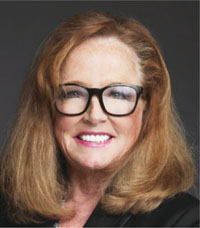Connecting people to new positions through networking and recruiting is my passion, but how it's accomplished today has changed significantly. For more than 20 years, Mitchell, Stankovic and Associates has dedicated resources to leadership development for executives and volunteers within the credit union industry. There used to be 100 resumes for any one CEO position and now there are fewer than 20, and they're mostly from bankers. You have to roll up your sleeves and engage with executives who are already in great positions. It is not only about compensation, it is about matching talent to culture!
The pace of business creates a dynamic, competitive environment and success is directly related to the leader's ability to execute key strategic initiatives in a manner consistent with board directives and member expectations. Credit unions are expected to face a leadership crisis in the next five years. It may be time to activate the legacy – to get the most out of the credit union's legacy team members and activate future leadership with the power of institutional knowledge.
The Social Security Administration estimates baby boomers are retiring at a staggering rate of 10,000 per day. This factor indicates that like other industries, credit unions will have a smaller talent pool available from which to fill management vacancies. Credit union CEOs are also nearing retirement age. Industry research indicates 50% of credit union CEOs were eligible for retirement in 2013, signifying that half of the industry may need to be replaced.
Leading a credit union is becoming more difficult as its complexity grows. Increased consumer demands, shrinking margins, competitive concerns and regulatory issues are all factors in this complexity. At the same time, as the expertise required to manage a credit union increases, the number of qualified applicants is decreasing. The entire financial services industry is facing a reduction in the number of available executives with the required skills and experience, meaning credit union executives are attractive candidates for opportunities beyond credit unions. This dichotomy will impact organizational effectiveness.
Who are the future candidates? Internal succession plans are being activated beyond the emergency document required by regulators and are becoming quite common. Firefighters First Credit Union and SCE Federal Credit Union are just two examples of organizations that have transitioned leadership internally. Their boards engaged in active conversation and due diligence to determine the next CEO.
“Nearing Firefighters First Credit Union's CEO retirement, I worked closely with the Board Succession Planning Committee to create an objective process,” Mary Steudle, SVP of human resources, said. “The committee was made up of current and past chairs to ensure a protection of the firefighter culture and positioning for the future.”
SCE Federal Credit Union had both its COO and CEO retire within six months of each other. The leadership transition was considered a multi-year development process for all senior level executives. Individual development plans were created and the CEO shared progress with the board regularly. Dennis Huber, the long-time CEO, announced his retirement three years in advance to create a transparent and open leadership discussion.
“I made changes to the organizational chart, adjusted reporting relationships and asked managers to embrace change,” Huber stated. “It simulated an external leader's potential impact on the organization and prepared all staff for my retirement.”

This example demonstrates the importance of deep bench strength within a credit union. The Pew Research Center reported that as of April 2016, the millennial generation will have surpassed the baby boomers as the largest generation. There are significant differences between the generations. Millennials are changing business trends and financial services will need to rely more on this generation. However, credit union “boomer” executives and volunteers are slow to integrate millennials into their leadership development programs and are rarely seen in the boardroom. This needs to change!
Credit unions must make this transition of leadership style and understand that new CEOs will have different skill sets than their predecessors. The need for executive talent that combines the knowledge of the financial services generalist with the organizational specialist necessitates a multi-dimensional leader. The expertise required based upon current market conditions is more complex and the competition for talent has increased, resulting in the need for competitive compensation packages.
The responsibility to recruit, select and assimilate new CEOs will fall on a volunteer pool that is also aging. The value of energizing and educating the board of directors on the realities of CEO replacement cannot be understated. Board members must know there may be sticker shock as they adjust compensation relative to the market and that CEO contracts are now written with change of control clauses based upon current merger trends. Million-dollar retirement plans and customized benefits are the norm and shouldn't be gasped at. The board must consider its compensation philosophy and establish targeted baselines that reflect appropriate market positioning while remembering that their philosophy will impact human resources' ability to recruit and retain talent. Is your target to be within the 50th percentile or 75th percentile, or should your target be subjectively established based upon individual skill set?
The following are trends and an overview of the components required for a credit union to recruit the best and brightest candidate in today's market.
-
Competitive base salary compensation will compare credit union industry data as defined by peer, regions and localized market considerations. The 2016 CUES Executive Compensation Survey reports CEO compensation levels increase as asset size categories increase. Base salary is not determined by the retiring CEO's compensation; it should be reflective of the current market conditions. A best practice for a high-performing board is to determine what the “new” CEO salary requirements will be and begin to adjust the retiring CEO compensation to that level. It is the right thing to do for the credit union and creates tremendous goodwill internally.
-
It should be noted that an external candidate may require higher compensation to make the change and internal candidates will also need a base adjustment. The significance of the adjustment ranges from 15% to 30% based upon the credit union's asset size.
-
Recognize the importance of performance-driven incentive. The majority of credit unions have a board-discretionary “at risk bonus” plan and most are transitioning to a performance metric system. According to the 2016 CUES Executive Compensation Survey, the majority of credit unions polled paid an incentive to their senior management team. The percentage of compensation fluctuated and was often driven by asset size. For those credit unions in the 75th percentile, the bonus payout for the CEO ranged from 15% to 23%.
-
Comprehensive executive benefits are still critical (health, life, vision, dental, 401(k), etc.).
-
Supplemental executive retirement plans, or SERPs, are considered retention tools and often required at the time of hire. D. Hilton's 2015 SERP Survey indicated 38% of CEOs received a SERP within three years of hire and 72.5% of CEOs reported that the SERP is a meaningful retention tool.
There are big challenges ahead that require modernization of leadership transition practices throughout the credit union industry. Activate the legacy of your existing senior leadership, executives and volunteers to create a win-win scenario. This strategic thinking is critical from the beginning as it sets the stage for long-term organizational health and member value.
 Susan Mitchell is CEO of Mitchell, Stankovic and Associates. She can be reached at 855-362-2002 Ext. 701 or [email protected].
Susan Mitchell is CEO of Mitchell, Stankovic and Associates. She can be reached at 855-362-2002 Ext. 701 or [email protected].
© Touchpoint Markets, All Rights Reserved. Request academic re-use from www.copyright.com. All other uses, submit a request to [email protected]. For more inforrmation visit Asset & Logo Licensing.






